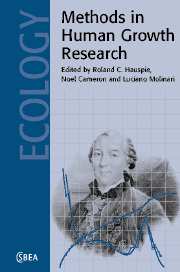Book contents
- Frontmatter
- Contents
- List of Contributors
- Foreword
- Acknowledgements
- Part I Growth data and growth studies: characteristics and methodological issues
- Part II Non-parametric and parametric approaches for individual growth
- Part III Methods for population growth
- Part IV Special topics
- 13 Methods for the study of the genetics of growth and development
- 14 Prediction
- 15 Ordinal longitudinal data analysis
- Index
15 - Ordinal longitudinal data analysis
Published online by Cambridge University Press: 17 August 2009
- Frontmatter
- Contents
- List of Contributors
- Foreword
- Acknowledgements
- Part I Growth data and growth studies: characteristics and methodological issues
- Part II Non-parametric and parametric approaches for individual growth
- Part III Methods for population growth
- Part IV Special topics
- 13 Methods for the study of the genetics of growth and development
- 14 Prediction
- 15 Ordinal longitudinal data analysis
- Index
Summary
Introduction
Growth data and longitudinal data in general are often of an ordinal nature. For example, developmental stages may be classified into ordinal categories and behavioural variables repeatedly measured by discrete ordinal scales. Consider the data set presented in Table 15.1. This table contains information on marijuana use taken from five annual waves (1976–80) of the National Youth Survey (Elliot et al., 1989; Lang et al., 1999). The 237 respondents were 13 years old in 1976. The variable of interest is a trichotomous ordinal variable ‘Marijuana use in the past year’ measured during five consecutive years. There is also information on the gender of the respondents.
Ordinal data like this is often analysed as if it were continuous interval level data, that is, by means of methods that imply linear relationships and normally distributed errors. However, the data in Table 15.1 is essentially categorical and measured at ordinal, and not at interval level. Consequently, a much better way to deal with such an ordinal response variable is to treat it as a categorical variable coming from a multinomial distribution; the ordinal nature of the categories is then taken into account by imposing particular constraints on the odds of responding, i.e. of choosing one category rather than another. As will be further explained below, an ordinal analysis can be based on cumulative, adjacent-categories, or continuation-ratio odds (Agresti, 2002). The constraints are in the form of equality or inequality constraints on one of these types of odds.
- Type
- Chapter
- Information
- Methods in Human Growth Research , pp. 374 - 393Publisher: Cambridge University PressPrint publication year: 2004
- 13
- Cited by



